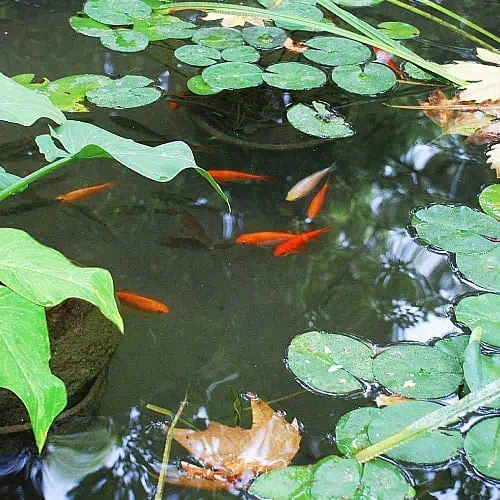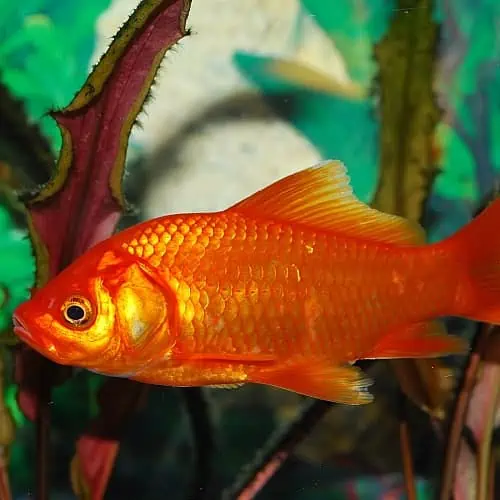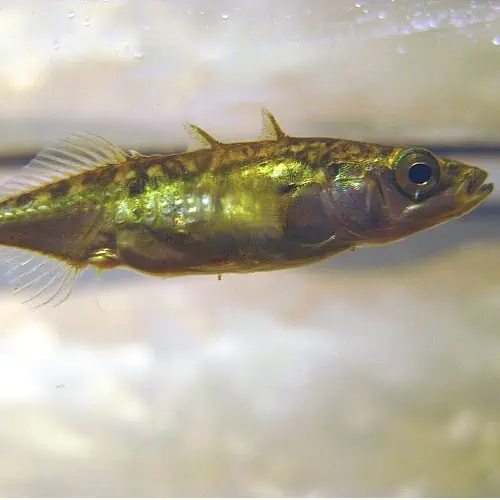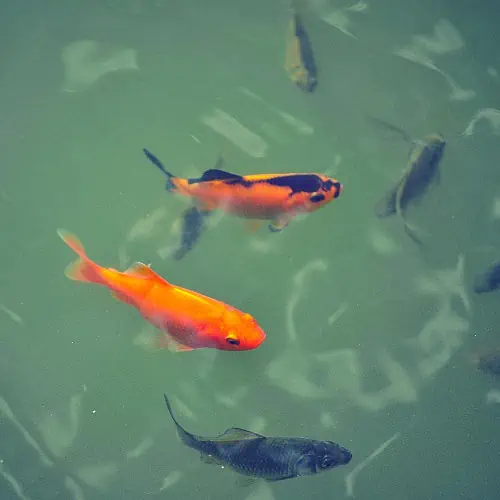
If your outdoor pond is between 50 and 500 gallons, you may be thinking that there’s less variety to the fish that you can have, particularly when taking into consideration the natural difficulties that come along with pond fish being outside in the elements. However, there are still many fish that you can keep in your small pond – you just have to think a bit outside of the box!
While you won’t be able to have koi and other popular larger fish species in your pond, the perk of this is that you’ll be able to have more species of smaller fish that might otherwise get eaten in a larger pond. In addition, small fish still provide many of the same benefits as larger fish – many of them eat insects and/or insect larvae, some may consume algae, they of course provide aesthetic and charming appeal, and help to promote a unique backyard ecosystem that aids a variety of wildlife, from bees to frogs! And, so long as you don’t overstock your pond, small fish will of course produce less waste for your pond (though you’ll still certainly need to clean and maintain it regularly).
Note: While the fish listed here are considered hardy, they certainly cannot survive being frozen solid and this is more of a concern in smaller ponds that freeze more easily and quickly than larger ponds. If you live in a colder climate (one that regularly drops below freezing), you may still need to bring these fish indoors for the winter.
The Best Small Pond Fish For Outdoor Ponds (50-500+ gallons)
1) Common Goldfish (Carassius auratus)

Though goldfish prefer temperatures that are between 68 and 72° F (20 to 22° C), they are able to overwinter so long as temperatures don’t drop below approximately 50° F (10° C). Once water temperatures hit that mark, goldfish enter a state of dormancy called torpor in which they conserve their energy and are thus able to overwinter outdoors so long as the pond doesn’t freeze entirely. A pH of 7.2 to 7.6 is the most suitable for them, though they can tolerate fluctuations in this better than most other domesticated fish. Common goldfish need to have at least 50 gallons of water per goldfish (ideally 100 gallons), while fancy goldfish may require more or less depending on their size or other factors; for example, pearlfish need closer to 30 or more gallons per fish due to the unexpected amount of waste that they generate relative to their smaller body size.
Goldfish are social fish and prefer to live in small to medium sized groups, so you’ll need to have more than just one or two in order to keep them happy and healthy. Common goldfish are overall laid back and very non-aggressive, but temperament can vary a bit more with fancy goldfish depending on the variety. Common goldfish tend to enjoy swimming about and are fairly active fish, so it may be best to not stock them with fish that are overly sensitive or easily stressed. Most fancy goldfish are slow and have a hard time competing with more zealous fish for food, so you shouldn’t keep common and fancy goldfish together. The average goldfish lifespan is around 10 to 25 years with proper care, though the oldest one on record lived to be 43!
2) Common Minnows (Phoxinus phoxinus)

The most commonly kept minnow species among ponders and aquarists is the fathead minnow, and so the term “common minnow” generally refers to them. Fatheads are an adaptable species that does well in cooler waters ranging from 53 to 68° F (12 to 20° C), often feeding on plant matter that is provided to them or that grows in your pond as well as adult and larval aquatic insects (including mosquitoes!) and algae. They’re native to much of North as well as Central America, though they do prefer cooler waters. They enjoy both swimming and lounging about, so your pond should have open space as well as hiding places like plants and hollow rocks or logs.
Very sturdy creatures, fatheads are able to withstand conditions that would cause most other fish to perish or become ill, such as low oxygen levels, high turbidity, or pH variances outside of their 7 to 7.5 range. Regardless, you should do your best to keep water moving only slowly, the temperature and pH within their preferred range, and oxygen levels at or above 7 parts per million (ppm). In addition, in the wild they keep together in schools of 5 or more, so apply this when keeping them as pets. Each fathead needs at least 10 gallons of water.
3) Mosquito Fish (Gambusia affinis)

As their name implies, mosquito fish (which are actually a variety of small minnow) are quite adept at consuming mosquito larvae, with just one mosquito fish eating anywhere from 100 to 500 of them in a single day! Each approximately 2 inch long adult needs at least 10 gallons of water, and the water should be between 50 and 84 °F (10-29 °C) with a pH ranging from 6 to 8. Since mosquitoes compose such a large portion of their diet in the wild, this means that mosquito fish can tolerate waters that have lower oxygen levels (do try not to let it fall below 5 ppm, though!) since mosquitos tend to lay their eggs in stagnant water. Much of their diet consists of insects and supplemented with a bit of plant matter and algae, so if you choose to feed them additional food aside from the natural insects that exist in the pond, stick to high protein snacks like brine shrimp or mealworms.
While mostly peaceful, mosquito fish have been known to be aggressive at times and nip the fins of slower fish or those with long fins. With this in mind, don’t keep them with long-finned species or with docile and easily bullied fancy goldfish. Due to their extreme hardiness, they make excellent fish for even first-time ponders. Keep in mind, however, that they breed very quickly and as such you’ll likely need to get rid of some after a while. In addition, they usually live 1 to 3 years (with this short lifespan contributing to their quick reproduction).
4) Sticklebacks (Gasterosteidae)

Sticklebacks, as covered in our article on unusual pond fish species, are small (less than 6 inches long) fish with a handful of bony armor plates that are more closely related to seahorses and pipefish than anything else. They’re bold and energetic, known to dart about ponds, but they aren’t known to pick on other fish with the exception of breeding season, during which males can become aggressive. The majority of their diet consists of aquatic macroinvertebrates like insects and crustaceans, but they’ll also eat tadpoles and the occasional bit of plant matter as well.
Perhaps the hardiest species on this list in terms of temperature, sticklebacks do just fine in waters as low as 39° F (3.8° C), though their general range of comfort is anywhere from 50 to 70° F (10 to 21° C); above 70° F and their metabolisms speed up to the point of illness. They prefer to be kept in groups of 5 or more, and again about 10 to 20 gallons of water per fish is suitable.
5) Red Shiners (Cyprinella lutrensis)

Native to North America, red shiners have silvery-blue bodies with vibrant red-orange fins and typically live around 3 years with proper care. In the wild, they’re often found in mountainous regions and as such are able to survive water temperatures as low as -21° C, though this is in extreme cases and water should be kept within the range of 59 and 77° F (15-25° C). They’re an active fish and can be known to nip fins, so don’t keep them with slow-moving fancy goldfish. Though tolerant of pH shifts from 5 to 10, water pH should be kept between 7 and 8 for red shiners, which are only about 2 to 3 inches long and need 20 to 30 gallons of water per individual. As with most small fish species, red shiners should be kept in groups of 5 or more so that they feel safe and comfortable.
6) Shubunkins & Comets (Carassius auratus)

Though both of these are varieties of goldfish, they are listed separately due to their popularity, hardiness, and uniqueness. Shubunkins and comets look quite similar at first glance, but shubunkins often have blueish coloring and longer, more flowy fins. Both are very peaceful (but lively and playful), can grow up to a foot in length (though about 5 to 6 inches is more common), and live up to 15 years if properly taken care of.
Each individual will need about 30-50 gallons of water in order to live comfortably, though closer to 50 works better since they are such active fish. Their temperature and pH parameters are the same as those listed in the goldfish section above. Comets in particular may nibble on plants (like water lettuce, hornwort, and anacharis), and also have a propensity to dig at substrate, perhaps out of nesting instinct, and as such may dig up smaller submerged plants.


i have a 11year old channel catfish in my 65 gallon tank. i just got a new load of fish and he ate them. He’s 2’3 inches long and weighs 11lbs. he needs a new home. ive had him since he was about an inch long! His tank mates (that he dont eat lol) is a 7 inch upside down catfish. And a 9 inch pleco. and a 8 inch koi. he needs a nice home!
I have the perfect outdoor pond for your channel catfish.
The pond is fed by a slow moving stream w a small waterfall at the opposite end of the pond.
There are small fish in the pond like mosquito fish and some crapys.
The pond has muddy areas but is mostly clear for the most part.
I would be happy to house him and give him a large environment in the Catskill region of New York to live out his life
I can be reached at
[email protected]
Thanks for reaching out and offering, Michael! This is very kind of you and I hope they were able to get in touch and give the fish a comfortable new home.
Found rich information. Excellent details for beginners.
Hi R. Jaganathan,
Thanks so much for reading and for your feedback! We’re glad that you found the information helpful!
Thank you for your informative site. I’ve passed this onto friends with a pond.
Hi. Any suggestions. I have a 15 gallon tub only that i wanted to put something in. Are there any small fiah i could put in, filtered water outdoor? Or any other amphibians etc?
15 gallons is relatively easy to heat so you could keep some guppies that prefer slightly warmer temperatures
Any of the list above should be fine, id stick to about 10 fish
10 to 20 gallons of water per fish. That means 1 fish for their mini aquarium. Most of these fish are brought inside to an indoor tank 3/4s of the year.
Just found you. Have been getting some advice from The Pond Guy but not on fish stock. My pond is about 30 thousand gallons with average depth of 4 1/2 feet. The bottom is pure muck about a foot deep as I gauge in my chest waders. Pond Guy wants to sell me muck eating bacteria. I could do that or just bucket out muck to the high side where the incoming water seeps in. The pond was designed to be much deeper with the overflow at 7 feet on the low side. That’s where the water leaks out due to poor design 20 years ago by previous owner. I don’t care to make it deeper, just less brown in color. There are no plants currently growing IN the pond, just around on a couple sides. Sides? It’s kidney shaped. I have frogs, several crustaceans and some left-over tadpoles. I had a thousand wood frog tadpoles till two weeks ago when they all grew their hind legs and took off. The ones remaining are a different kind, maybe the same as the 4 or 5 frogs that inhabit. One kind of those shows no fear of me, allowing me to touch without escaping. I just bought this place last year and truly love having a pond. It is well shaded by a maple under which I sit in a gravity chair. I ran a wire trolley the 50 foot length about 6 feet above the water u pon which I placed 6 bird feeders. It is arranged with a bungy cord to pull it back to the middle after re-filling the feeders. This is an attempt to outsmart the black bears that destroyed my last-years attempt. I also, this time, have attached a fence charger of 10 thousand volts to the feed storage barrel and several other parts. I was really OK last year until the pond froze allowing easier access.
Living in Scotland what fish would you recommend for a pond?
Hi Zac,
What part of Scotland do you live in – mountainside, coastal, etc.? That influences climate and which fish might be more suitable.
I live in North Scotland on the coast and have a 100 gallon raised pond in the back garden which contains 6 red shiners and 6 medaka rice fish and they have survived their first Scottish winter out doors and are fit and healthy
hey i have a 9 gallon pond thats in my basement its also gonna be heated it has a faster flow so a betta wont do good i kinda wanted to put some creek fish in it because of the flow like some darters of some smaller type of minnow
i need some stocking help with my 9 gallon pond.
Really enjoyed your comments about the best fish to choose for a pond, but I am still unsure about which fish would suite me best. I have a new 3500 L, i would like to stock small and hardy fish; definitely smaller that koi. My pond freezes over, so the fish have to be winter stable down to 2-4 deg C. Any suggestions would be gratefully received.
Wintering fish is all about preventing the pond from freezing over entirely. Regardless of the size of your fish, install an air pump for aeration and run it for 12 months of the year. I’m in Canada & my coi and other fish winter in the pond. I maintain a 1-2 foot hole with the aerator and a small floating heater. If you don’t want coi, try red and/or sarasa comets and Shubunkins. All hearty fish with nice colour. Glen
Gambusia affinis,since mosquitos tend to lay their eggs in stagnant water as you clam. as you seem to be very unaware they are live bearers and certanly need clean water with a temp around 15/25c, as they are truly live bearers and a also tail nippers to gold fish it is not wise to mix or interact this bread with gold fish,tale nippers as there known to do, they breed like guppys once pregnated by the male they a pregnate for life,I persoaly caught 2 femails from my local river system yes both femal without the annal spure,but I found young within 9-12 months latter in my pond,to all out there please be aware relocatting these fish can cause an issue, there born for survival at any cost
Hy Ayooo, post date June 4th, 4pm
I am interested to buy all your fishes. I have 350 gallon tank . Please contact me ASAP.
I have a small out side pond I’m guessing aprox> 150 gallon. I have 5 gold fish in it that have lived in it for at least 5 years. I put a small oond heater in it every winter. 2 years ago in the summer I put 4 4and 5 inch bluecat fish in it also. I have a small filter in the bottom just in the late spring to about November. One day this spring all 4 cat fish were belly up the same day. They were doing real good and growig till this happened. The gpld fish as active as ever. Any idea you can shed on this I would really appreciate very much. Thanks–William Sims
Hi William,
I’m really sorry to hear about your catfish. There are many possible reasons why catfish might die suddenly, such as drastic changes in water quality, temperature, or even disease, parasites, predators, or stress. Without knowing more details about your pond and how you care for your fish, it’s hard to pinpoint the exact cause. However, some general tips to prevent catfish deaths are:
– Test your water regularly and keep it clean and well-oxygenated.
– Avoid drastic changes in temperature or pH levels (your young catfish may not have tolerated the conditions as well as your mature goldies)
– Provide adequate hiding places and cover for your catfish to feel safe and comfortable (if your catfish were more curious and brave they may have been snatched by a predator!).
– Feed your catfish a balanced and varied diet that meets their nutritional needs.
– Quarantine any new fish before adding them to your pond to prevent introducing diseases or parasites.
– Monitor your fish for any signs of illness or injury and treat them promptly.
I wish you all the best with your pond and your goldfish.